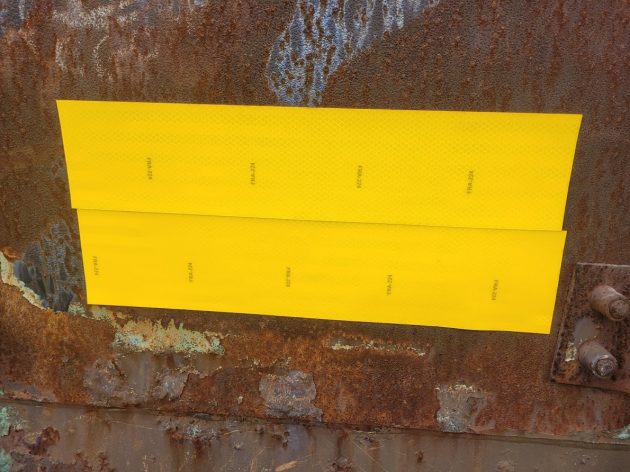
Surprise: That old track is not as abandoned as it looked a couple weeks before.
That dead-end section of railroad track in central Albany looked abandoned, as I wrote on May 13. But it’s not.
The track ends in weeds and brush just short of Hill Street south of the Crabtree Automotive business. But it is still in use, at least occasionally, to store pieces of rolling stock half full of railroad junk.
I learned this on a return visit to the spot on May 30. I also learned something else, something about railroad rules.
The cars on the track that day were beat up from what seemed like many decades of heavy use. Their steel walls were rusty and bent. But they had yellow stickers on the outside, and the stickers were new, like these:

I wondered what they meant. They said “FRA 224,” and I assumed that was some Federal Railroad Administration code for derelict rail cars too old and worn out to be allowed to be used in regular service.
No, that wasn’t it. When I looked it up I found that “FRA 224” refers to a section of the Code of Federal Regulations that was updated in 2005. It says rail cars must have reflective markings to help prevent accidents at grade crossings when visibility is bad.
The idea is that drivers would see the reflectors even if they don’t see the train itself.
The rule applies to freight cars and locomotives, but for some reason tank cars and flat cars are exempt.
The reflective strips can be yellow or white. At least one strip of 4 by 36 inches, or two strips of 4 by 18 inches (one above the other) must be applied as close as possible to each end of the car. Between the ends, reflective tape must be applied every 12 feet.
New freight cars must have the reflectors when they are, well, new. Old ones, like those on the track that day, must get them within nine months of a “single car airbrake test.”
This suggests the cars on the track have been recently tested, which means they are not useless at all.
Now, when you sit at a crossing watching a freight go by, check for those reflective strips. And if you see them, you’ll know the reason they are there. (hh)

A length of rail rusts inside the freight car along with other stuff.


H.H., that R/R line once extended thru what’s now part of Lowe’s and thru to Crabtree & beyond. It crossed I-5 & thru Timberline Park. If ever you get a chance look at old Arial photos. In some places of Timber Linn Park you can still make out the ‘ole track bed going east, N/E. When I got here in late ’71 that track was still used up to Oak St.
Uh oh! Looks like Hasso climbed up on railroad equipment to get a better look.
Watch out for the RR Cops Hasso, with that picture in open circulation.
On the other hand, a new nickname of “Hobo Hasso” conjures up a sort of wonderful alliterative nostalgic feel for times gone by.
Thanks, but actually, the front end of that car was missing, so no climbing was required to get a look inside.
Thank you so much for that interesting investigation Hasso. I always learn something new when I visit with you. And I appreciate it.